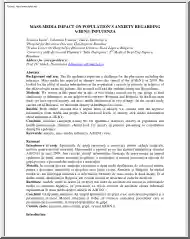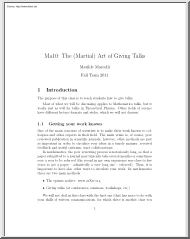No comments yet. You can be the first!
What did others read after this?
Content extract
FACT SHEET THE ECONOMIC IMPACT OF THE MEAT INDUSTRY IN THE U.S A 2012 Meat and Poultry Industry Economic Impact study measured the combined impact of the meat and poultry processing and hide, skin and off al production industries (meat and poultry products). The industry is defi ned to include not only the production of meat and poultry-based products, but meat distribution and retailing. The industry contributes approximately $894 billion in total to the U.S economy, or just under 6 percent of total US GDP and, through its production and distribution linkages, impacts fi rms in all 440 sectors of the U.S economy, directly and indirectly providing 5.9 million jobs in the US Production The production process begins in one of four ways. In the case of slaughtering, livestock (including cows, pigs, sheep, goats, etc.) are purchased from farmers and brought to slaughterhouses for conversion into raw meat sides. Meat and poultry packers use either live animals (like chickens) or raw
meat products and convert these to either fresh or packaged meat. Alternatively, hides and skins are purchased from slaughterhouses and converted to raw (untanned) leather or fur products. The 8,433 firms that convert livestock to meat and poultry and other products or directly import meat into the United States are denoted as producers.All told, these fi rms employ over 543,500 people in production or importing operations, sales, packaging, and direct distribution. These are good jobs paying good wages and benefi ts Today, every job is important. Wholesale Once meat and poultry products have been produced or imported, they enter the second tier of the industry – the wholesaling tier. Wholesalers are involved in the transportation of meat an poultry products from the producers or a bonded warehouse opperated by importers, and the storage of products for a limited period of time. This study takes into account the fact that different types of wholesalers sell different amounts of
meat and poultry as a percentage of their total sales. We estimate that there are approximately 168,000 employees at wholesalers whose jobs depend on the wholesaling of meat and poultry products. Retail Finally, the third tier of the industry directly sells products to the consumer. This can either be through on-premises sales (as in the case of a restaurant), or for off -premises consumption (grocery stores, butchers, etc.) For the analysis, the retail tier is assumed to consist of fi rms in the following industries: restaurants and taverns, grocery stores, meat and fi sh markets, fruit and vegetable markets, dairy products stores, retail bakeries and miscellaneous food stores. While there are obviously other venues that may sell meat and poultry products to the public – street vendors, cruise lines, non-profi t groups, etc. they are not included in the analysis due to limited data availability or the small amount of product that they handle. It is estimated that there are
approximately 1,385,000 employees whose jobs depend on the sale of meat and poultry products to the public. The production, wholesale and retail sectors, defi ned as the direct industry, combine for a total of 2.1 million jobs, generating $68 billion in wages and providing more than $278.9 billion in total economic output Suppliers Other firms are related to the meat and poultry industry as suppliers. These firms produce and sell a broad range of items including livestock, fuel, packaging materials, sales displays or machinery. In addition, supplier fi rms provide a broad range of services, including personnel services, fi nancial services, advertising services, consulting services or even transportation services. Finally, a number of people are employed in government enterprises responsible for the regulation of the meat and poultry industry.All told, we estimate that the meat and poultry industry is responsible for 2,084,100 supplier jobs with these firms generating over
$363.3 billion in economic activity Induced Impact While it is inappropriate to claim that suppliers to the supplier fi rms are part of the industry being analyzed, the spending by employees of the industry and those of supplier fi rms whose jobs are directly dependent on meat and poultry sales and production should surely be included. This spending on everything from housing, to food, to educational services and medical care makes up what is traditionally called the “induced impact” or multiplier eff ect of the industry. In other words, this spending, and the jobs it creates is induced by the production, distribution and sale of meat and poultry products. It is estimated that the induced impact of the industry is more than $252.1 billion, and generates 1,755,600 jobs, for a multiplier of about 2.2 The broader economic impact fl ows throughout the entire economy, generating businesses for fi rms and companies seemingly unrelated to meat. These are real people with real jobs,
paying taxes, working in industries varied as banking, retail, trucking, accounting, or metalworking, who depend on the meat and poultry industry for their livelihood. An important part of an impact analysis is the calculation of the contribution of the industry to the public fi nances of the community. In the case of the meat and poultry industry, this contribution comes in two forms. First, the traditional direct taxes paid by the fi rms and their employees provide over $95.8 billion in revenues to the federal, state and local governments. In addition, the consumption of meat and poultry generates $3 billion in state sales taxes. These are billions of taxpayer dollars that are put towards our education system, our roads and national defense. January 2015 » North American Meat Institute » 1150 Connecticut Avenue, NW 12th Floor » Washington, D.C 20036 » p: (202) 587-4200 » f: (202) 587-4300 » wwwmeatinstituteorg NAMI FACT SHEET: THE ECONOMIC IMPACT OF THE MEAT INDUSTRY IN
THE U.S - CONTINUED Methodology This Meat and Poultry Industry Economic Impact Model (Model) was developed by John Dunham and Associates based on data provided by Dun and Bradstreet (D & B, Inc.), the US Department of Agriculture and various state agriculture departments. The analysis utilizes the Minnesota IMPLAN Group Model in order to quantify the economic impact of the meat and poultry industry on the economy of the United States. The model adopts an accounting framework through which the relationships between diff erent inputs and outputs across industries and sectors are computed. This model can show the impact of a given economic decision – such as a factory opening or operating a sports facility – on a predefi ned, geographic region. It is based on the national income accounts generated by the US Department of Commerce, Bureau of Economic Analysis (BEA). For a complete methodology report and summary, visit www.meatfuelsamericacom THIRD-PARTY EXPERTS John Dunham
President, John Dunham & Associates 32 Court Street, Suite 207 New York, NY 11201 212-239-2105 HELPFUL LINKS Meat Fuels America www.meatfuelsamericacom North American Meat Institute http://www.meatinstituteorg Meat Safety http://www.meatsafetyorg January 2015 » North American Meat Institute » 1150 Connecticut Avenue, NW 12th Floor » Washington, D.C 20036 » p: (202) 587-4200 » f: (202) 587-4300 » wwwmeatinstituteorg
meat products and convert these to either fresh or packaged meat. Alternatively, hides and skins are purchased from slaughterhouses and converted to raw (untanned) leather or fur products. The 8,433 firms that convert livestock to meat and poultry and other products or directly import meat into the United States are denoted as producers.All told, these fi rms employ over 543,500 people in production or importing operations, sales, packaging, and direct distribution. These are good jobs paying good wages and benefi ts Today, every job is important. Wholesale Once meat and poultry products have been produced or imported, they enter the second tier of the industry – the wholesaling tier. Wholesalers are involved in the transportation of meat an poultry products from the producers or a bonded warehouse opperated by importers, and the storage of products for a limited period of time. This study takes into account the fact that different types of wholesalers sell different amounts of
meat and poultry as a percentage of their total sales. We estimate that there are approximately 168,000 employees at wholesalers whose jobs depend on the wholesaling of meat and poultry products. Retail Finally, the third tier of the industry directly sells products to the consumer. This can either be through on-premises sales (as in the case of a restaurant), or for off -premises consumption (grocery stores, butchers, etc.) For the analysis, the retail tier is assumed to consist of fi rms in the following industries: restaurants and taverns, grocery stores, meat and fi sh markets, fruit and vegetable markets, dairy products stores, retail bakeries and miscellaneous food stores. While there are obviously other venues that may sell meat and poultry products to the public – street vendors, cruise lines, non-profi t groups, etc. they are not included in the analysis due to limited data availability or the small amount of product that they handle. It is estimated that there are
approximately 1,385,000 employees whose jobs depend on the sale of meat and poultry products to the public. The production, wholesale and retail sectors, defi ned as the direct industry, combine for a total of 2.1 million jobs, generating $68 billion in wages and providing more than $278.9 billion in total economic output Suppliers Other firms are related to the meat and poultry industry as suppliers. These firms produce and sell a broad range of items including livestock, fuel, packaging materials, sales displays or machinery. In addition, supplier fi rms provide a broad range of services, including personnel services, fi nancial services, advertising services, consulting services or even transportation services. Finally, a number of people are employed in government enterprises responsible for the regulation of the meat and poultry industry.All told, we estimate that the meat and poultry industry is responsible for 2,084,100 supplier jobs with these firms generating over
$363.3 billion in economic activity Induced Impact While it is inappropriate to claim that suppliers to the supplier fi rms are part of the industry being analyzed, the spending by employees of the industry and those of supplier fi rms whose jobs are directly dependent on meat and poultry sales and production should surely be included. This spending on everything from housing, to food, to educational services and medical care makes up what is traditionally called the “induced impact” or multiplier eff ect of the industry. In other words, this spending, and the jobs it creates is induced by the production, distribution and sale of meat and poultry products. It is estimated that the induced impact of the industry is more than $252.1 billion, and generates 1,755,600 jobs, for a multiplier of about 2.2 The broader economic impact fl ows throughout the entire economy, generating businesses for fi rms and companies seemingly unrelated to meat. These are real people with real jobs,
paying taxes, working in industries varied as banking, retail, trucking, accounting, or metalworking, who depend on the meat and poultry industry for their livelihood. An important part of an impact analysis is the calculation of the contribution of the industry to the public fi nances of the community. In the case of the meat and poultry industry, this contribution comes in two forms. First, the traditional direct taxes paid by the fi rms and their employees provide over $95.8 billion in revenues to the federal, state and local governments. In addition, the consumption of meat and poultry generates $3 billion in state sales taxes. These are billions of taxpayer dollars that are put towards our education system, our roads and national defense. January 2015 » North American Meat Institute » 1150 Connecticut Avenue, NW 12th Floor » Washington, D.C 20036 » p: (202) 587-4200 » f: (202) 587-4300 » wwwmeatinstituteorg NAMI FACT SHEET: THE ECONOMIC IMPACT OF THE MEAT INDUSTRY IN
THE U.S - CONTINUED Methodology This Meat and Poultry Industry Economic Impact Model (Model) was developed by John Dunham and Associates based on data provided by Dun and Bradstreet (D & B, Inc.), the US Department of Agriculture and various state agriculture departments. The analysis utilizes the Minnesota IMPLAN Group Model in order to quantify the economic impact of the meat and poultry industry on the economy of the United States. The model adopts an accounting framework through which the relationships between diff erent inputs and outputs across industries and sectors are computed. This model can show the impact of a given economic decision – such as a factory opening or operating a sports facility – on a predefi ned, geographic region. It is based on the national income accounts generated by the US Department of Commerce, Bureau of Economic Analysis (BEA). For a complete methodology report and summary, visit www.meatfuelsamericacom THIRD-PARTY EXPERTS John Dunham
President, John Dunham & Associates 32 Court Street, Suite 207 New York, NY 11201 212-239-2105 HELPFUL LINKS Meat Fuels America www.meatfuelsamericacom North American Meat Institute http://www.meatinstituteorg Meat Safety http://www.meatsafetyorg January 2015 » North American Meat Institute » 1150 Connecticut Avenue, NW 12th Floor » Washington, D.C 20036 » p: (202) 587-4200 » f: (202) 587-4300 » wwwmeatinstituteorg




